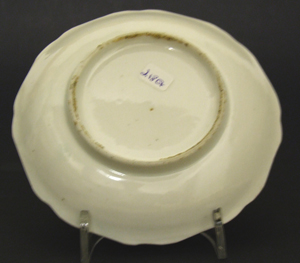
KAKIEMON c.1690 – 1700. Japanese Porcelain.
A Japanese Kakiemon Nigoshide Porcelain Saucer c.1690- 1700. Decorated with a Bird on a Flowering Prunus Branch.
SOLD
- Condition
- Perfect.
- Size
- 11 cm (4 1/4 inches)
- Provenance
- N/A
- Stock number
- 218071
- References
- For a pair of similar Japanese Kakiemon Porcelain saucers from the John Drew Collection, 18602 and other similar examples 20491, 20607, see `Archives` or `Sold`. Another Kakiemon saucer of this type can be seen in : Japanese Export Porcelain, Catalogue of the Collection of the Ashmolean Museum, Oxford (Dr.Oliver Impey, Hotei Publishing, 2002) page 165 plate 251. For a further similar Kakiemon saucer of a similar design see : The Japanese Aesthetic, Three Centuries of Japanese Porcelain Design and Western Interpretations (The Ceramic and Glass Circle of Australia, 2006). Page 12 plate 17.
Information
Kakiemon Porcelain :
Kakiemon decoration is usually of high quality, often delicate and with well-balanced asymmetric designs. The designs were normally quite sparse emphasizing the fine white porcelain body known in Japan as Nigoshide (milky white). The opaque white milky Nigoshide body was used on the finest pieces, it appears that it was reserved for fine quality enamelled decoration. Kakiemon porcelain was decorated with a great variety of imaginative designs which include elements such as the `banded hedge`, `flying squirrel`, and the `Quail and Millet` design. The `Three Friends of Winter` were also a very popular group of designs, other subject taken from nature include flowers (especially the chrysanthemum, the national flower of Japan) as well as birds and rock-work. Figural subjects such as the `Hob in the Well` were also popular. This design illustrates a Chinese folk tale where a sage saves his friend who has fallen into a large fish-bowl by throwing stones at it, braking open the pot. Banded-Hedges were a formal device within Japanese traditional gardens, they were often incorporated in designs, includes `The Three Friends of Winter` (Pine, Bamboo and Prunus). These three plants signify perseverance, as neither the pine nor the bamboo shed their leaves in winter and the plumb (Prunus) flowers at the very end of the winter, heralding the arrival of spring.
Nigoshide Body :
The Nigoshide (milky white) body was a new whiter porcelain body introduced between about 1660 - 1680, solely for use on Kakiemon Wares. Indeed the Kakiemon Palette evolved at the same time. It has recently been proposed that the Nigoshide Body is not a new body at all, rather it is just made from a clay that has been levigated and washed more thoroughly.